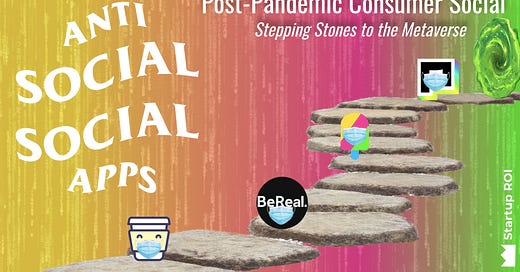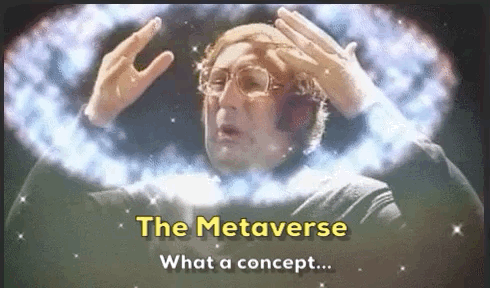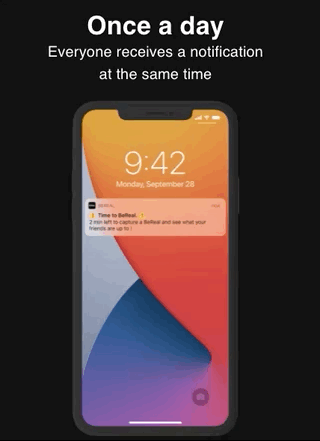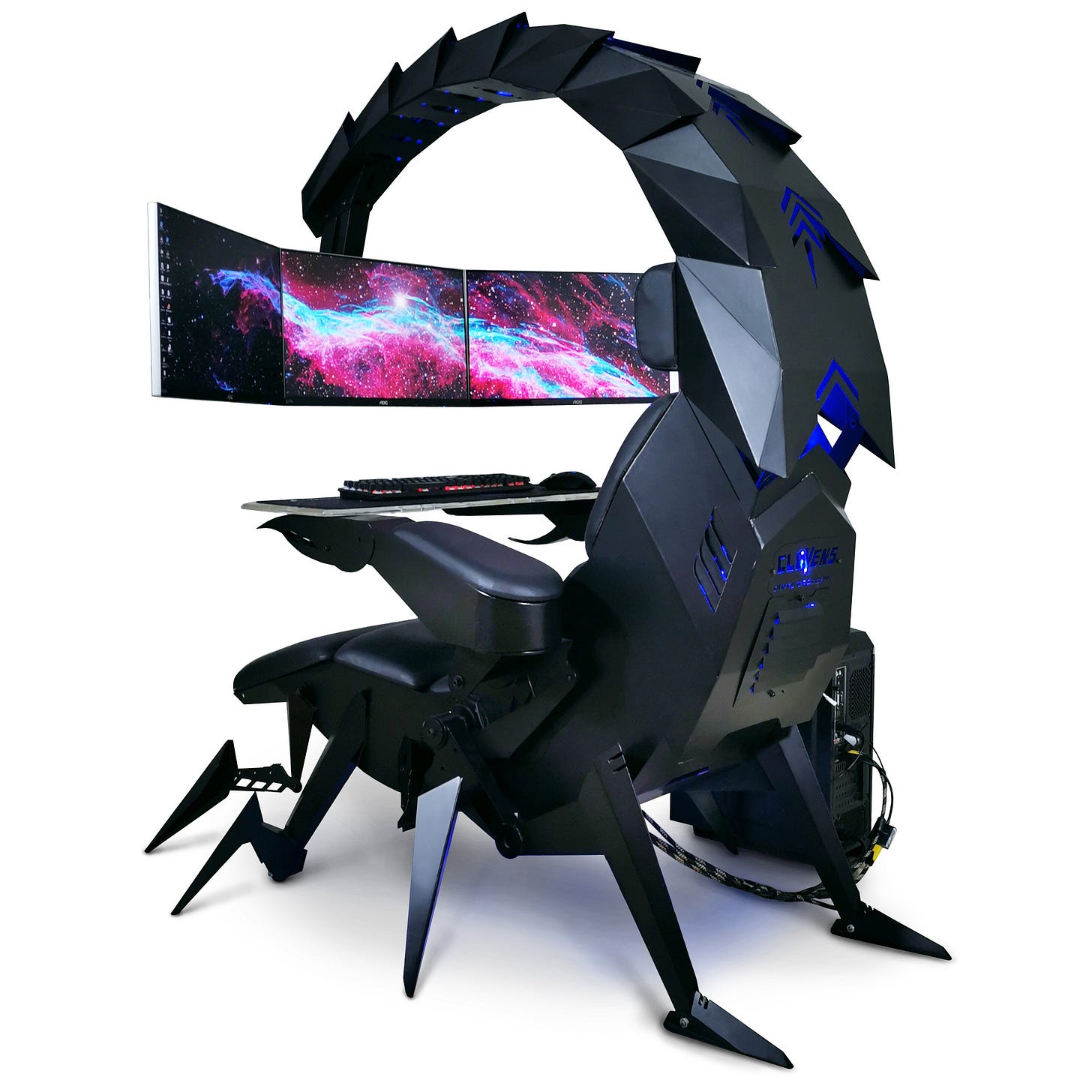The Metaverse: Preloaded
If you stopped a random person on the street in 1995 and asked them, can you explain the internet to me? You would probably get one of several answers. Some people might shrug and say, What's the internet? Others might quote a relatable analogy they heard on the news like "it's the information superhighway" or "the world wide web"! But even the most tech-savvy of respondents wouldn't be able to explain the ubiquitous utility the internet has become and how it's transformed virtually every aspect of modern society.
That's kind of where we are with the metaverse today.
My understanding of the metaverse, though admittedly novice, goes something like this:
In the future, there will be some sort of convergence of the physical and digital worlds that we currently inhabit separately
Much in the way the internet connects us to virtual information across the globe, a combination of hardware (sensors, IoT devices, etc.), software, networking, vast amounts of computing power, payment services and interchange protocols will serve as the connective tissue between these two worlds
Our identities, experiences, roles in society and even relationships will exist across planes; actions in the virtual world will have consequences in the physical world and vice versa
To be sure, this is an abstract concept. Even the foremost experts have trouble detailing exactly what this future might hold for us. The best overview I've found is Matthew Ball's The Metaverse Primer which I'll reference regularly throughout this piece. It's a 7 part-series covering every subject that will have a meaningful impact on how the metaverse comes to fruition:
Hardware
Networking
Compute
Virtual Platforms
Interchange Tools & Standards
Payments
Content, Services & Assets
Underpinning all of this, however, is the evolution of user behavior. Our willingness to adapt and adopt new technologies. In Ball's essay(s), he looks backward to technology trends that shaped our present in an effort to uncover and explain how exactly we begin to converge on something like the metaverse. Today, I want to explore current technologies, specifically consumer social apps (in France!), and how they might just point towards subtle shifts in user behavior that are priming us for our future experiences in the metaverse.
In today's piece:
Welcome to the Metaverse
Hear Me Out (Audio)
Pseudonymous Authenticity (Visual)
Charting the Way (Augmented Reality, Maps)
Fresh Powder (Filming the Metaverse)
Enter the Metaverse
Welcome to the Metaverse
I turned thirty over the weekend. While I don't feel overwhelmed with the clichés of this milestone birthday, over the past several years, I've started to sense a temporal undertow — like I'm slipping away from the generation of "now," the generation big media has their eye on. I'm a millennial, so I'm accustomed to getting skewered in the news for being lazy, overly sensitive, entitled etc. But as of late, the great lens of humanity has shifted its gaze to Gen-Z. If Millenials felt foreign to traditional media then Gen-Z must present as an alien species. I was born an "internet native" but my Gen-Z friends received a social media profile with their birth certificate. Without a doubt, there are some bizarre phenomena that have emerged from this newest generation, but the reality is that it's easy to shrug off something you're either uncomfortable or unfamiliar with as weird or silly. Today, I'm checking my "millennial status" at the door and diving into some uncharted territory (for me, at least). Oftentimes, things we consider trivial toys of the younger generation turn out to be paradigm shifts. So I'd say it's best not to overlook them.

The graphic above is an illustration from Ball's metaverse primer highlighting key areas that will makeup it's supporting technology ecosystem. A lot of those terms probably sound familiar. And they should. We aren't building the metaverse in a vacuum. Think of it more as a new "era" of the internet. A good "historical" analogy is what we refer to as the mobile web. For a long time, we accessed the internet via browser on a computer. Eventually, some flip phones had nascent browsing capabilities. Then, the iPhone came out followed by the app store. It took several iterations for us to reach the general mobile-first philosophy that has come to dominate modern product development. It wasn't a flip of the switch, but a gradual convergence of technologies, collective intelligence, user behaviors and availability of hardware. This too will be the case with the metaverse. My objective today is to share with you some of the changes that are already taking place and the consumer social apps powering some of these underlying behavioral shifts.
But before we do, it's important we review one last thing. In the past decade, our behavior online has transformed dramatically (duh). We generate and store unprecedented volumes of data, we stream insane amounts of content (the avg. American streamed 600 hours of Netflix alone in 2020), we spend trillions of dollars using digital payment methods each year. These are all mind-blowing changes. But nowhere does the convergence of data, payments, and virtual representation converge more than in the gaming industry.
It’s no coincidence that all of the leading virtual platforms today originated in gaming. Games have long been the most complex, scaled, and diverse simulations, as no other consumer-grade experience required a comparable amount of computing power.
—Matthew Ball
For better or for worse, I'm not a gamer (my first and only love was Crash Bandicoot on PS1). But unless you've truly gone off the grid in the past year, you've probably seen emerging games (and gaming platforms) like Fortnite and Roblox in the news. The goal here is not to debate the intricacies of gaming culture but to point out that online gaming has always been ahead of the curve as it pertains to pushing the boundaries across all the categories listed above. Things like hyper-realistic graphics (GPUs), concurrent multiplayer environments (low latency), building virtual worlds and even making in-game purchases (outfits, weapons, etc.). This is why, perhaps, gaming is the strongest approximation of the metaverse that exists today. What we'll try to do next is expand our narrow view of the metaverse (gaming) and imagine how we could port over several of these characteristics to our personal online and offline presence.
Just as our lives changed in myriad unexpected ways from the internet, so too will our experience in the metaverse. Today, we have the ability to be in two places at once (at home and in the office) even if it doesn't literally feel that way. In the metaverse, we may interact in virtual worlds of our own creation combining audio/visual sensations, haptics, and unprecedented real-time computing power to experience those virtual places we plan to visit (hopefully not just the office!). Imagine an afternoon holiday on another planet or a quick face-to-face conversation with a relative half-way across the globe. We can even imagine going to a concert with millions of other virtual beings where you can genuinely feel the sound waves coming out of the speakers or brush up against a stranger. In fact, this already happened (albeit more limited than my fantasy version) with Travis Scott inside a virtual Fortnite environment.

Since I'm not a "hardware guy," I'm going to focus the remainder of this article on 3 of the aforementioned categories supporting the metaverse ecosystem and how they will inevitably influence our entry into said metaverse. While the underlying technical aspects are critical, I'm personally more interested in the content, virtual platforms and user behavior that will collectively get us across the threshold.
The next segments will cover specific consumer social products made in France. At first glance they may not appear to be catalysts for the metaverse, but upon closer inspection, they are rewiring our approach to engaging with what's to come. Each offers a distinct feature-set that will be critical stepping stones to our adjustment to this future state and may just give us a glimpse into how we are already shaping the inevitable singularity.
Hear me Out (Audio)
Prior to launching this newsletter, I was working at a podcasting startup so it's no surprise that audio was a core component of our "corporate culture." During confinement, we used Cappuccino FM to retain the social element of our workday. The premise is simple: record a "bean" (read: voice note) in the app each Monday to talk briefly about your weekend or some to-do's for the week ahead. Once everyone has submitted, the app stitches together the mp3s with some nice intro/outro music and audio blending so you have a mini podcast to wake up to the following day. It was a nice way to fill the social void created by the pandemic.
It wasn't until much later that I learned Cappuccino wasn't just a pandemic era employee engagement tool but a real consumer social app that was going viral. If you go to their Twitter page it's flooded with people sharing how much they love hearing their friends' voices each morning or feel more connected than ever with loved ones. It's actually pretty heartwarming.
The idea started as a WhatsApp group where friends sent voice notes that were manually stitched together in GarageBand for a highlight reel the following day. Eventually, the founders — Olivier Desmoulin & Gilles Poupardin — hacked together a prototype using Airtable. Today, their app has over 225K users, 130K groups, and a million audio stories. With the advent of AirPods and the increasing adoption of voice technology, it's clear that audio has an important place in our future.
By no means am I implying that this cute app set out with intentions to accelerate our entrance into the metaverse. But I think it's worth acknowledging how, in conjunction with the pandemic, apps like this have become more commonplace (yes, Clubhouse is still a thing). Though Cappuccino might strictly be a virtual audio universe, it's virtual nonetheless. It's a far cry from full-blown immersion, but Cappuccino is helping establish the neural pathways for us to more easily process intimacy and relationships as a function of sound/voice instead of physical proximity.
Pseudonymous Authenticity (Visual)
As our social media presence becomes a more vital component of our personal identity, so too have efforts to curate the perfect public persona. What started as mere photo sharing has transformed into manicured online identities meant to convey a more perfect version of our lives. But years of asynchronous, highly polished social personas has led to a push for authenticity and a sense of community. Nevertheless, in our highly developed digital world, authenticity comes with tradeoffs: censorship, criticism, cancelation. In the digital universe we are building towards, therefore, it is critical that we strike a balance between the two. Which is why an app that enables what I'll call pseudonymous authenticity may attract a lot of attention and satisfy a craving of the masses.

What you might not have guessed is that one of the next social media powerhouses was conceived in France. BeReal, which raised $30M in June from investors including Andreessen Horowitz, has emerged as a leader in this new space. They seem to have threaded the needle between authenticity and privacy, enabling users to adjust their discoverability and manage degrees of visibility (name & location). To take on the challenge of authenticity, the app works like this:
Each day, you receive a notification at a random time to take a photo
The app captures an image from both the front and back cameras on your phone
You have 2 minutes after receiving the notification to take said photo (time to BeReal!)
No edits, filters or the like: simply post it
Even if you were able to capture the perfect selfie, you may reveal that you are sitting in a cubicle or lounging in bed from the front angle camera. The combination of randomness, time limits, and double camera exposure make for funny outcomes rooted in authenticity. Furthermore, you're encouraged to use realMojis: snap a selfie resembling a popular reaction emoji instead of sending the emoji itself. Authenticity meets avatar.
I would consider this a very early step towards re-aligning social media with an online presence that is simultaneously safe and authentic. But it's an important step if we look forward to a scenario in the metaverse. A degree of trust is important in any interaction, but especially as we begin to abstract away the elements we can rely on (physical presence, voice, access to information). Circling back to the idea of shifting user behaviors in preparation for step changes in our digital environments, BeReal may be a key ingredient to repositioning our perception of social media and re-training a generation around important concepts ranging from identity and privacy to digital trust and authenticity.
Charting the Way (Augmented Reality, Maps)
Chances are, if you're reading this, you own a smartphone. And I wouldn't be surprised if one of your most commonly used apps is either (a) a mapping tool or (b) leverages some sort of mapping functionality to contextualize the information you are looking at (i.e. where you are, where it is, where x is in relation to y, and how to get there fastest). There are tons of cool features on apps like Google Maps beyond identifying the fastest route. I, for one, tag interesting places I visit or read reviews to determine which nearby cafe I'll grab a coffee from before my next appointment. If you take a moment to consider the amount of real-time data getting pulled into this application, it's pretty astounding: traffic, weather, user input, 3rd party APIs, variable pricing, public transportation updates, etc. In fact, Google purchased a company called Waze to add even more texture to their mapping interface. This extract (again from Matthew Ball's Primer on the Metaverse) shows us how far we've come in terms of mapping our surroundings:
Many new smartphones, including the iPhone 11 and iPhone 12, feature new ultra-wideband chips that emit 500,000,000 RADAR pulses per second and receivers that process the return information. This enables smartphones to create extensive RADAR maps of everything from your home, to your office, and the street you’re walking down — and place you within these maps, relative to other local devices, down to a few centimeters. This means your home door can unlock when you approach from the outside, but remain closed from the inside. And using a live RADAR map, you’ll be able to navigate much of your home without ever needing to remove your VR headset.
— Matthew Ball
If we conduct another thought experiment about how this metaverse might be experienced in the future, there are tons of other (key) data points that would figure into the equation. Location data, for example, has two connotations: physical and digital. And perhaps actions that take place in a virtual world will have real life consequences (say you won big at a virtual casino but wanted to cash out here on Earth). In essence, for our maps to be functional in the metaverse, there needs to be a social layer (one that accounts for identity, physical & digital location, purchases/exchanges, & relationships). So far, the closest I've come to this sort of experience is through Zenly, a French start-up aiming to build the map of the future.
The app, which was acquired in 2017 by Snap Inc. for around $300M, wasn't always the poster child of "La French Tech." They initially launched as a tool for parents to track their kids' smartphones but saw an opportunity to pivot when they discovered teens hated being tracked but loved sharing their location with friends. Once acquired, they were credited as the technological backbone for Snapchat's "Snap Map" but remained largely independent, continuing to improve upon the growth they were seeing natively.
The app's algorithm is intelligent, quickly identifying key locations like your home and place of work. Over time it gains a sense of your general trajectory and also generates real-time status updates for your friends within the experience so they can get a sense for where you are at any given moment: are you on your way home or still at the office for the 16th hour straight? But augmented reality and gamification is where you really start to get a sense of the future.
At your disposal, is a suite of "lenses" that enable you to overlay a dataset on the map. Standard overlays like weather and traffic are useful, but information on coronavirus vaccination centers (and vaccination rates by region), public toilets (#necessary) or basketball courts turn generally static data into part of your exploration of the city. In addition, all the key components of any social tool: direct messaging, voice to text, emojis etc. are included in the app. Not to mention Zenly is packed with little "easter eggs" — surprise features — that motivate you to test and explore within the app regularly.
A recent brand experience led by Zenly's brand marketing guru, Sarah McBride, is what really highlights their potential as a bridge to the metaverse. The event took place in Japan where one day, an ice-cream truck (digital, not physical) appeared on the Zenly map, tracing a cross-country trip around the island with a mysterious countdown clock hovering above it. What's fascinating here is the fact that your physical proximity (i.e. living in Japan) determines your digital proximity (i.e. your ability to see the ice cream truck in-app) and interact with the experience. This is a concrete example of how blending digital and physical "locations" will have consequences for the way we engage with our environment and our friends. Zenly's brand activation event resulted in more than just a digital scavenger hunt — there was a merch store, influencer marketing, media hype and a 5ft. ($14K) popsicle statue. Sarah recounts her learnings here (worth a read!), but my main takeaway is this: the vector connecting today's Zenly experience to something resembling the metaverse is clear.
Fresh Powder (Filming the Metaverse)
Let's finish up where we started: gaming. If you were thinking "wow, this article isn't meta enough for me..." well, you're in luck! We've talked about building our way towards a metaverse, but how are we going to document it? That's where Powder comes in. Even if you're unfamiliar with gaming, you've probably heard of streamers who rake in millions of dollars broadcasting themselves playing some of the most popular games on the market. For any skeptics out there, the global gaming market in 2020 was about $175B and is projected to reach $314B by 2026 (according to Mordor Intelligence). For us "normies," the closest experience is probably something like sports, but in virtual environments with hundreds of players and otherworldly capabilities (including camera angles), the experience can be enhanced.
Powder let's gamers record, edit, and share clips from their best moments of gameplay. Its AI identifies highlights automatically. You can even join their community to network or leverage your skills for gaming stardom. Just to review the workflow here: you sign up for Powder, play a game of Fortnite, select top highlights to edit on your phone and then directly distribute to your social channels (TikTok, Snapchat etc.). In and of itself, the technology is pretty cool. But let's take it a step further, shall we?
Have you ever wished you could have a highlight reel of your day (IRL, that is)? If we extend these capabilities beyond gaming and virtual worlds and into the metaverse, this seems like a realistic possibility. Documenting your journey between realms, all the while a metaverse platform in the background is stitching together data and maintaining the fabric of our constructed reality.
Enter the Metaverse
The building blocks for the metaverse are already here. But this will be a gradual shift, not an overnight change. And frankly, I'm grateful for that. As we begin to lay the groundwork for this so-called metaverse, we should think about the impact of each and every stepping stone. It will be critical to build with intention. Despite abstracting away our physical presence we should aim to retain the humanity in the worlds we build — both physical and digital. In 2005, you probably couldn't have conceived that a simple photo-sharing app with birthday reminders would contribute to electing a bigoted, former reality star to the White House. That's why I believe it's important we look to the consumer social apps we use today in order to extrapolate how we might unleash power beyond our current imagination. And based on these #FrenchTech pioneers, I think we're in good hands.
I'll leave you with one last quote from the document that inspired this piece:
We must also consider the role of changing user capability. The first iPhone could have skipped the home button altogether, rather than waiting until the tenth. This would have opened up more room inside the device itself for higher-quality hardware or bigger batteries. But the home button was an important training exercise for what was a vastly more complex and capable mobile phone than consumers were used to. Like closing a clamshell phone, it was a safe, easy, and tactile way to ‘restart’ the iPhone if a user was confused or tapped the wrong app. It took a decade for consumers to be able to have no dedicated home button. This idea is critical. As time passes, consumers become increasingly familiar with advanced technology, and therefore better able to adopt further advances - some of which might have long been possible!
— Matthew Ball
Sometimes, it's the users, not the technology that's holding us back from progress. Who knows… maybe tomorrow the proverbial "home button" will disappear and we'll enter the metaverse in one fell swoop. There's no turning back!
Wanna share the article with friends who don't like to read? Here's a recap:
I hope you're enjoying this as much as I am — please share with other smart/interesting/wildly successful people such as yourself! 😉
The “one-stop-shop” ➡️ Click Here
🐦 Twitter: @StartupROI & @RoiStartup 🧐 choose wisely
👔 LinkedIn: Startup ROI
📸 Instagram: @startuproi
🎁 Feedback is a gift — 📩 bonjour@startup-roi.com
P.S. Will be writing all future articles from my “Metaverse HQ” 👇🏼















